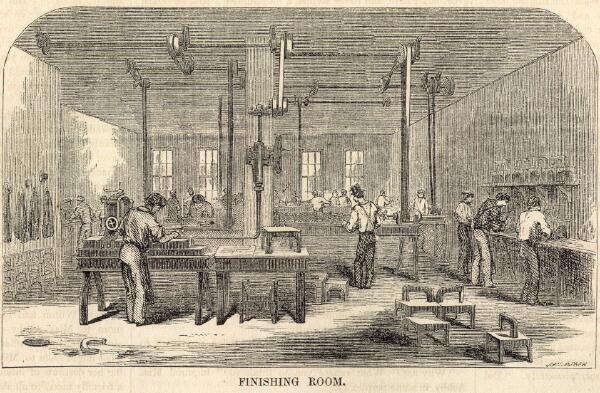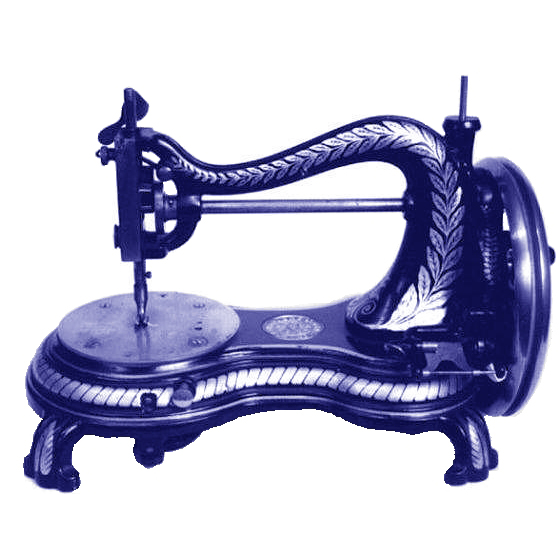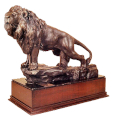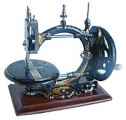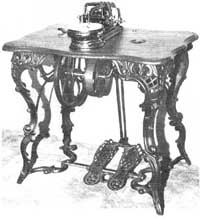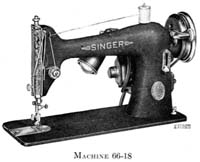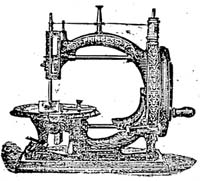Hunt & Webster's Sewing Machine -- and the Emancipation of Women
The following article appeared in Ballou's Pictorial Drawingroom Companion, July 5th 1856. The article provides us with a fascinating glimpse into the mindset in the Machine Age just a scant few years after the introduction of the sewing machine, which, it turns out, was already proving to be the Great Emancipator of women and the key to Domestic Bliss in the home -- and pretty handy for use in industry, too!
While the article concentrates on the benefits of the sewing machine to industry, family, and the society at large, it also promotes Boston-based Hunt & Webster's sewing machine as an example of Yankee ingenuity. The article praises Mr. Hunt especially, and it is apparent that the writer sees Mr. Hunt as the founder of the company and Mr. Webster as a young assistant. This may have been the actual relationship between the two, but other sources I've consulted suggest that the company was already making machines under the name "Hunt & Webster" as early as 1853, so the partnership could well have been in place from the beginning. The article promises that Hunt will "reap a rich reward" for his efforts in the business, but it appears that this did not happen; the illustrious Mr. Hunt was soon to be replaced by a Mr. Ladd. According to Bays (The Encyclopedia of Early American Sewing Machines), Ladd & Webster began production in 1858 and continued to do so for another eight years. Cooper (The Invention of the Sewing Machine) mentions only Ladd & Webster, not Hunt. Although Hunt is described in the article as a "mechanic," I haven't been able to locate any sewing machine patents issued to him -- or to Webster or Ladd, for that matter. According to Bays, the original machine was manufactured under license from Elias Howe . It occurs to me that the Mr. Hunt of Hunt & Webster could have been somehow related to the famous sewing machine inventor Walter Hunt of New York , but I've found no evidence to support this.
The article is illustrated with engravings of three steps in the process of manufacturing the machine and a fourth engraving of the sales showroom.
Ballou's was a Boston magazine, and it's not surprising that it promotes a Boston company and praises the shoe industry of Massachusetts for its foresight in embracing technological advances. It is apparent from the slant of the article that, by 1856, the sewing machine had become commonplace in industry but was still struggling to take hold in homes; the writer promotes family use of the sewing machine in general and of the Hunt & Webster in particular.
There are no paragraphs in the original article; I have added them because I can't stand to read it without them. There is some very interesting syntax in the article; this has been left intact for your bemusement and amusement.
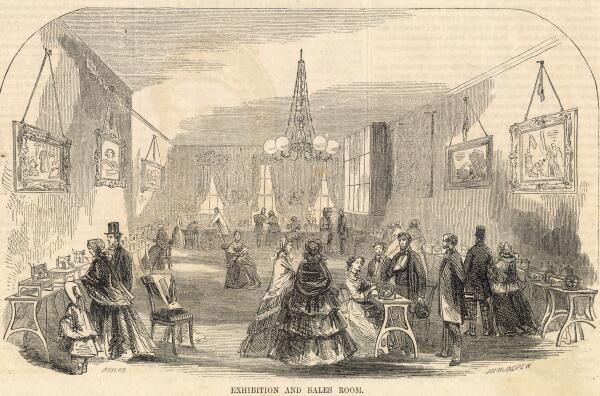
Hunt & Webster's Sewing Machine Manufactory
There is no application of machinery to useful purposes that we have watched with more interest than that destined to lighten the manual labor of females in sewing. The manufacture of garments for domestic wear is a never-ending task. The brain is bewildered in attempting to estimate the many millions of stitches which must be made daily in these United States alone. Who can forget the pathos of Hood's " Song of the Shirt ;" a song that has found an echo in the hearts of thousands of poor wretches doomed to "stitch, stitch, stitch," from the rising of the sun far beyond the going down thereof? Who shall say how many a bright thought has been lost to the world -- how many a bright spirit extinguished, for the want of labor-saving machinery to perform the work of those busy fingers which have moved for many a lifetime in the service of humanity?
At one time, even inventors gave up in despair the hope of making the needle operate in fingers of iron and steel instead of the delicate instruments of nature's handiwork. But the problem was at last solved -- and the solution was the emancipation of hundreds of thousands. The amount of domestic happiness thus secured baffles calculation. A sewing machine in a family works morally as well as mechanically -- it benefits the mind and heart as well as the purse.
The intimate connection between morals and happiness and machinery affords one of the most interesting subjects for speculation and comment that can well be conceived. One can hardly realize the change that has taken place in many branches of business in consequence of the introduction of sewing machines. A few years ago and all the labor in the shoe manufacturing business was performed by hand; while now but a small portion is achieved by manual labor, nearly all, in fact, being done by the little labor-saving machines. A few years ago even, when sewing machines were first introduced, our southern and western merchants used to write "Don't send me any boots, shoes or clothing made on machines." Now they order the machine-made articles. Why? Simply because the stitch is more perfect, handsome and durable, and is, in every way, better when made on machines like those we have illustrated on the present page, and which we have delineated because they mark an important point in the progress of useful invention.
The shoe trade in Massachusetts last year amounted to fifty-five millions of dollars, and the reason why our State has done so much more than any other in this necessary branch of business, is, that next to their untiring industry and perseverance, the shoe manufacturers of Massachusetts have always heartily and readily seconded the efforts of inventors and mechanics to perfect this so much needed improvement in their business. One establishment, the "North American Shoe Company," at Ballard Vale, have over fifty of the latest improved machines represented in our drawings, now running, and are increasing the number every week. This is a single establishment; but they are running in every town in the commonwealth. This machine is not confined to the shoe business in its various branches. Tailors, hatters, upholsterers, mattress makers, bag makers, glove makers, coach trimmers, dress makers, corset makers and shirt makers employ it. In short, show us wherever a thread is drawn, and we will show you the machine to do it. Folders and binders are attached for binding, whenever it is necessary for any article.
For all kinds of family use, these machines are really invaluable. Simple and beautiful in their construction, making no more noise in running than a set of knitting needles in the hands of a smart old lady, they are free from a serious objection which has been alleged against the use of machinery for sewing.
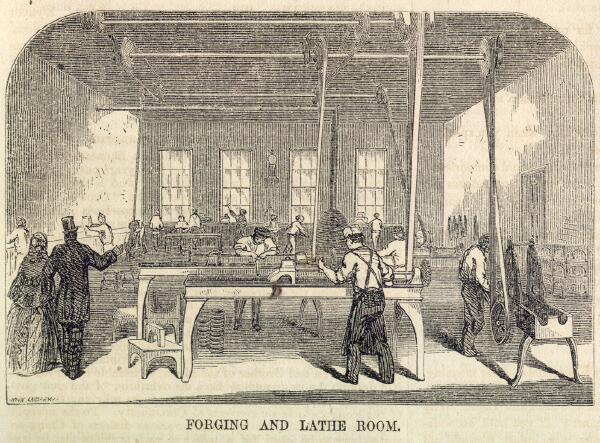
Mr. Hunt, the principal in the manufacture of these machines, is likewise at the head of the house of N. Hunt & Co., manufacturers of leather belting. He is a Boston merchant as well as a Boston mechanic; a modest, unassuming man, of indomitable perseverance and energy. He has labored for years to bring his sewing machine to the position it now occupies, and it has been no easy matter to accomplish this. It has required a vast amount of labor as well as a large outlay of money; but he has succeeded, and we doubt not that he will reap a rich reward from his investment of capital, labor, time and thought. Mr. Webster, who is now associated with Mr. Hunt in the manufacture and sale of these sewing machines, is a young man of industry and business capacity, and we venture to predict that Messrs. Hunt & Webster will occupy a front rank in the phalanx of the sewing machine fraternity, in the sale of machines as they now do in the manufacture of them.
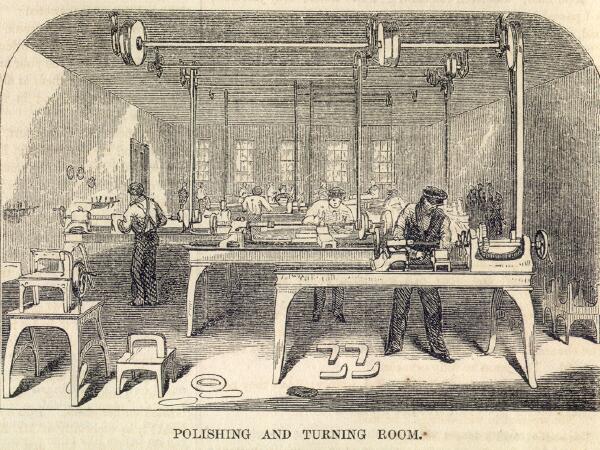
The engravings on this page represent different departments in the establishment of Messrs. Hunt & Webster, Nos. 26 and 30 Devonshire Street, viz.: the "Forging and Lathe Room," where the work is begun, the "Polishing and Turning Room," and the "Finishing Room," whence the completed machines pass into the "Sales Room."
